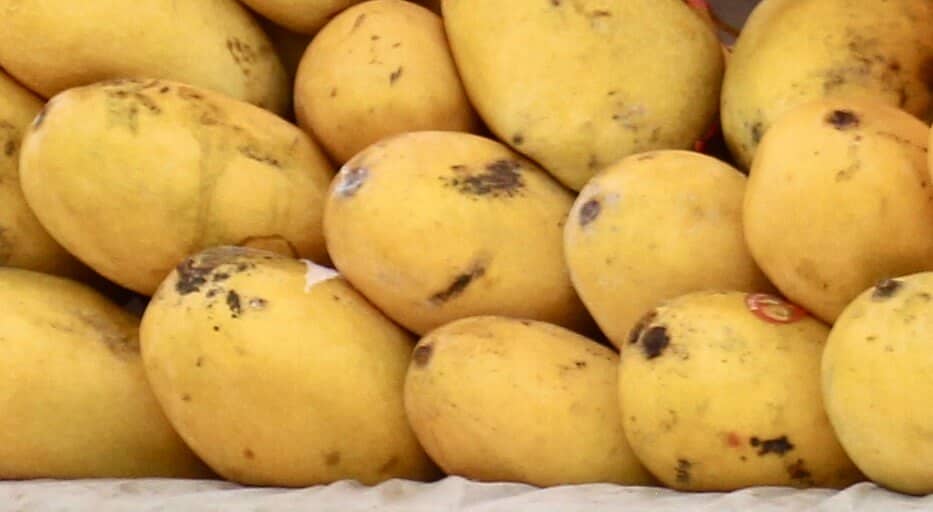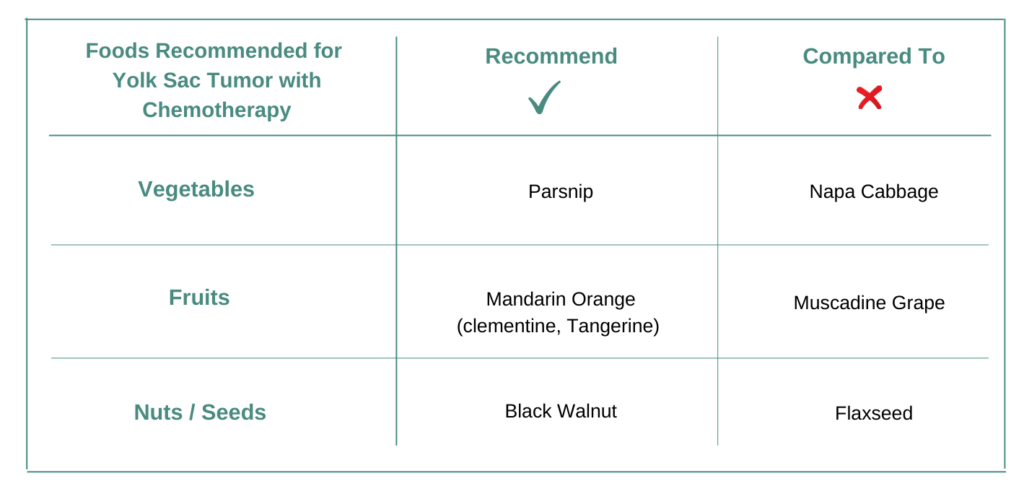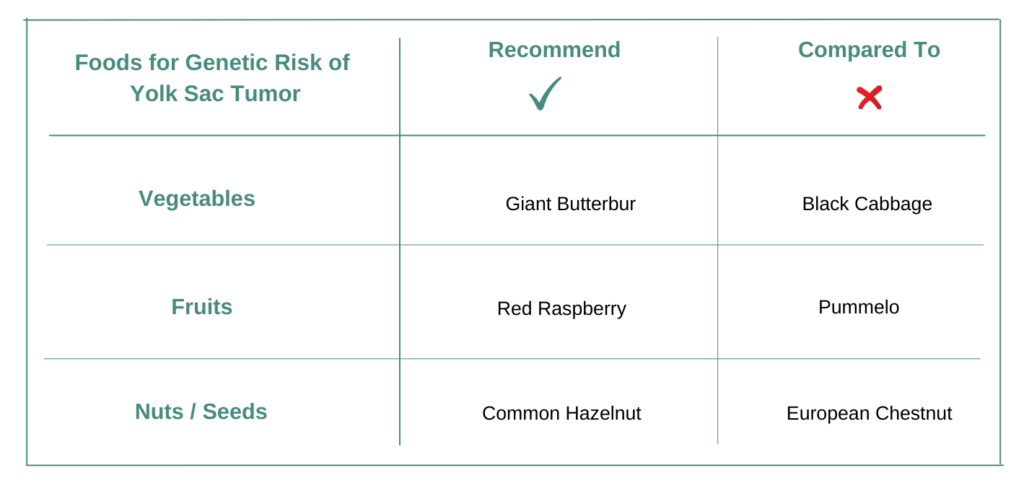Introduction
Foods for Yolk Sac Tumor should be personalized for each individual and also must adapt when cancer treatment or tumor genetic change. The personalization and adaptation must consider all the active ingredients or bioactives contained in different foods with respect to cancer tissue biology, genetics, treatments, lifestyle conditions and diet preferences. Hence while nutrition is one of the very important decisions for a cancer patient and individual at risk of cancer to make – how to choose foods to eat is not an easy task.
Yolk Sac Tumor, also known as endodermal sinus tumor, is a rare type of germ cell tumor that can occur in both males and females, though its presentation differs by sex and age. The tumor is most commonly found in the testis in males and the ovary in females. Detailed pathology outlines for yolk sac tumors are crucial for accurate diagnosis, especially considering the distinct features of this tumor in different locations, such as the ovary and testis.
A key aspect of diagnosing yolk sac tumors is the identification of specific tumor markers, with Alpha-fetoprotein (AFP) being a primary marker. Elevated AFP levels are often associated with yolk sac tumors and are useful both in diagnosis and in monitoring treatment response.
The survival rate and prognosis of yolk sac tumors depend on various factors, including the stage of the tumor at diagnosis, the patient’s age, and the response to treatment. In general, yolk sac tumors in children have a better prognosis than in adults. Treatment typically involves a combination of surgery and chemotherapy, and the approach can vary depending on the tumor’s location and the patient’s age.
Radiological imaging plays a significant role in the diagnosis and staging of yolk sac tumors. Imaging techniques such as ultrasound, CT scans, and MRI can help delineate the extent of the disease and guide surgical planning.
Symptoms of yolk sac tumors can vary depending on their location. In the ovaries, they may present with abdominal pain or a palpable mass, while in the testis, a painless swelling is more common. Early detection and treatment are critical for improving outcomes. Regular follow-ups are important due to the risk of recurrence and to monitor for any long-term effects of treatment.
For Yolk Sac Tumor does it matter what vegetables, fruits, nuts, seeds one eats?
A very common nutrition question asked by cancer patients and individuals at-genetic risk of cancer is – for cancers like Yolk Sac Tumor does it matter what foods I eat and which I do not? Or if I follow a plant-based diet is that enough for cancer like Yolk Sac Tumor?
For example does it matter if vegetable Parsnip is consumed more compared to Napa Cabbage? Does it make any difference if fruit Muscadine Grape is preferred over Mandarin Orange (clementine, Tangerine)? Also if similar choices are made for nuts/seeds like Black Walnut over Flaxseed and for pulses like Alfalfa over Catjang Pea. And if what I eat matters – then how does one identify foods which are recommended for Yolk Sac Tumor and is it the same answer for everyone with the same diagnosis or genetic risk?
Yes! Foods you eat matters for Yolk Sac Tumor!
Food recommendations may not be the same for everyone and can be different even for the same diagnosis and genetic risk.

All foods (vegetables, fruits, nuts, seeds, pulses, oils etc.) and nutritional supplements are made up of more than one active molecular ingredient or bio-actives in different proportions and quantities. Each active ingredient has a unique mechanism of action – which can be activation or inhibition of different biochemical pathways. Simply stated foods and supplements which are recommended are those which do not cause an increase of molecular drivers of cancer but reduce them. Else those foods should not be recommended. Foods contain multiple active ingredients – hence when evaluating foods and supplements you need to consider the impact of all active ingredients cumulatively rather than individually.
For example Muscadine Grape contains active ingredients Protocatechuic Acid, Curcumin, Apigenin, Ellagic Acid, Caffeine. And Mandarin Orange (clementine, Tangerine) contains active ingredients Linalool, Protocatechuic Acid, Curcumin, Daidzein, Lupeol and possibly others.
A common mistake made when deciding and choosing foods to eat for Yolk Sac Tumor – is to evaluate only selected active ingredients contained in foods and ignore the rest. Because different active ingredients contained in foods may have opposing effects on cancer drivers – you cannot cherry pick active ingredients in foods and supplements for making a nutrition decision for Yolk Sac Tumor.
YES – FOOD CHOICES MATTER FOR CANCER. NUTRITION DECISIONS MUST CONSIDER ALL ACTIVE INGREDIENTS OF FOODS.
Skills Needed for Nutrition Personalization for Yolk Sac Tumor?
Personalized nutrition for cancers like Yolk Sac Tumor consists of recommended foods / supplements; not recommended foods / supplements with example recipes which prioritize use of recommended foods. An example of personalized nutrition can be seen at this link.
Deciding which foods are recommended or not is extremely complicated, requiring expertise in Yolk Sac Tumor biology, food science, genetics, biochemistry along with good understanding of how cancer treatments work and associated vulnerabilities by which the treatments could stop being effective.
MINIMUM KNOWLEDGE EXPERTISE NEEDED FOR NUTRITION PERSONALIZATION FOR CANCER ARE: CANCER BIOLOGY, FOOD SCIENCE, CANCER TREATMENTS AND GENETICS.
Foods to Eat After Cancer Diagnosis!
No two cancers are the same. Go beyond the common nutrition guidelines for everyone and make personalized decisions about food and supplements with confidence.
Characteristics of cancers like Yolk Sac Tumor
All cancers like Yolk Sac Tumor can be characterized by a unique set of biochemical pathways – the signature pathways of Yolk Sac Tumor. Biochemical pathways like RAS-RAF Signaling, DNA Repair, PI3K-AKT-MTOR Signaling, Cell Cycle Checkpoints are part of the signature definition of Yolk Sac Tumor. Each individual’s cancer genetics can be different and hence their specific cancer signature could be unique.
The treatments which are effective for Yolk Sac Tumor need to be cognizant of the associated signature biochemical pathways for each cancer patient and individual at genetic risk. Therefore different treatments with different mechanisms of actions are effective for different patients. Similarly and for the same reasons foods and supplements need to be personalized for each individual. Hence some foods and supplements are recommended for Yolk Sac Tumor when taking cancer treatment Bleomycin, and some foods and supplements are not recommended.
Sources like cBioPortal and many others provide population representative patient anonymized data from clinical trials for all cancer indications. This data consists of clinical trial study details like sample size / number of patients, age groups, gender, ethnicity, treatments, tumor site and any genetic mutations.
TP53, KRAS, CBL, ROS1 and PALB2 are the top ranked reported genes for Yolk Sac Tumor. TP53 is reported in 46.2 % of the representative patients across all clinical trials. And KRAS is reported in 30.8 %. The combined population patient data cover ages from 31 to 51. 88.1 % of the patient data are identified as men. The Yolk Sac Tumor biology along with reported genetics together define the population represented signature biochemical pathways for this cancer. If the individual cancer tumor genetics or genes contributing to the risk are also known then that should also be used for nutrition personalization.
NUTRITION CHOICES SHOULD MATCH WITH EACH INDIVIDUAL’S CANCER SIGNATURE.
Food and Supplements for Yolk Sac Tumor
For Cancer Patients
Cancer patients on treatment or on palliative care need to make decisions on food and supplements – for the needed dietary calories, for managing any treatment side effects and also for improved cancer management. All plant-based foods are not equal and choosing and prioritizing foods which are personalized and customized to ongoing cancer treatment is important and complicated. Here are some examples providing guidelines for making nutrition decisions.
Choose Vegetable PARSNIP or NAPA CABBAGE?
Vegetable Parsnip contains many active ingredients or bioactives such as Protocatechuic Acid, Curcumin, Quercetin, Daidzein, Lupeol. These active ingredients manipulate various biochemical pathways like DNA Repair, PI3K-AKT-MTOR Signaling, MAPK Signaling and MYC Signaling and others. Parsnip is recommended for Yolk Sac Tumor when ongoing cancer treatment is Bleomycin. This is because Parsnip modifies those biochemical pathways which have been scientifically reported to sensitize the effect of Bleomycin.
Some of the active ingredients or bioactives in vegetable Napa Cabbage are Protocatechuic Acid, Curcumin, Lupeol, Daidzein, Isoliquiritigenin. These active ingredients manipulate various biochemical pathways like DNA Repair and others. Napa Cabbage is not recommended for Yolk Sac Tumor when ongoing cancer treatment is Bleomycin because it modifies those biochemical pathways which make the cancer treatment resistant or less responsive.
VEGETABLE PARSNIP IS RECOMMENDED OVER NAPA CABBAGE FOR Yolk Sac Tumor AND TREATMENT Bleomycin.
Choose Fruit MANDARIN ORANGE (CLEMENTINE, TANGERINE) or MUSCADINE GRAPE?
Fruit Mandarin Orange (clementine, Tangerine) contains many active ingredients or bioactives such as Linalool, Protocatechuic Acid, Curcumin, Daidzein, Lupeol. These active ingredients manipulate various biochemical pathways like PI3K-AKT-MTOR Signaling, MAPK Signaling, NFKB Signaling and MYC Signaling and others. Mandarin Orange (clementine, Tangerine) is recommended for Yolk Sac Tumor when ongoing cancer treatment is Bleomycin. This is because Mandarin Orange (clementine, Tangerine) modifies those biochemical pathways which have been scientifically reported to sensitize the effect of Bleomycin.
Some of the active ingredients or bioactives in fruit Muscadine Grape are Protocatechuic Acid, Curcumin, Apigenin, Ellagic Acid, Caffeine. These active ingredients manipulate various biochemical pathways like DNA Repair and others. Muscadine Grape is not recommended for Yolk Sac Tumor when ongoing cancer treatment is Bleomycin because it modifies those biochemical pathways which make the cancer treatment resistant or less responsive.
FRUIT MANDARIN ORANGE (CLEMENTINE, TANGERINE) IS RECOMMENDED OVER MUSCADINE GRAPE FOR Yolk Sac Tumor AND TREATMENT Bleomycin.
Choose Nut BLACK WALNUT or FLAXSEED?
Black Walnut contains many active ingredients or bioactives such as Protocatechuic Acid, Curcumin, Apigenin, Ellagic Acid, Quercetin. These active ingredients manipulate various biochemical pathways like PI3K-AKT-MTOR Signaling, MAPK Signaling and MYC Signaling and others. Black Walnut is recommended for Yolk Sac Tumor when ongoing cancer treatment is Bleomycin. This is because Black Walnut modifies those biochemical pathways which have been scientifically reported to sensitize the effect of Bleomycin.
Some of the active ingredients or bioactives in Flaxseed are Protocatechuic Acid, Curcumin, Apigenin, Lupeol, Daidzein. These active ingredients manipulate various biochemical pathways like MAPK Signaling, DNA Repair and PI3K-AKT-MTOR Signaling and others. Flaxseed is not recommended for Yolk Sac Tumor when ongoing cancer treatment is Bleomycin because it modifies those biochemical pathways which make the cancer treatment resistant or less responsive.
BLACK WALNUT IS RECOMMENDED OVER FLAXSEED FOR Yolk Sac Tumor AND TREATMENT Bleomycin.

For Individuals with Genetic Risk of Cancer
The question asked by individuals who have genetic risk of Yolk Sac Tumor or familial history is “What Should I Eat Differently from Before?” and how they should choose foods and supplements to manage risks of the disease. Since for cancer risk there is nothing actionable in terms of treatment – decisions of foods and supplements become important and one of the very few actionable things which can be done. All plant-based foods are not equal and based on identified genetics and pathway signature – the choices of food and supplements should be personalized.
Choose Vegetable GIANT BUTTERBUR or BLACK CABBAGE?
Vegetable Giant Butterbur contains many active ingredients or bioactives such as Curcumin, Apigenin, Delphinidin, Formononetin, Myricetin. These active ingredients manipulate various biochemical pathways like Angiogenesis, Growth Factor Signaling, MAPK Signaling and RAS-RAF Signaling and others. Giant Butterbur is recommended for risk of Yolk Sac Tumor when associated genetic risk is CBL. This is because Giant Butterbur increases those biochemical pathways which counteract the signature drivers of it.
Some of the active ingredients or bioactives in vegetable Black Cabbage are Curcumin, Apigenin, Delphinidin, Formononetin, Myricetin. These active ingredients manipulate various biochemical pathways like DNA Repair, Insulin Signaling and Oxidative Stress and others. Black Cabbage is not recommended when risk of Yolk Sac Tumor when associated genetic risk is CBL because it increases the signature pathways of it.
VEGETABLE GIANT BUTTERBUR IS RECOMMENDED OVER BLACK CABBAGE FOR CBL GENETIC RISK OF CANCER.
Choose Fruit RED RASPBERRY or PUMMELO?
Fruit Red Raspberry contains many active ingredients or bioactives such as Ellagic Acid, Curcumin, Quercetin, Delphinidin, Formononetin. These active ingredients manipulate various biochemical pathways like Angiogenesis, MAPK Signaling, Cell Cycle Checkpoints and RAS-RAF Signaling and others. Red Raspberry is recommended for risk of Yolk Sac Tumor when associated genetic risk is CBL. This is because Red Raspberry increases those biochemical pathways which counteract the signature drivers of it.
Some of the active ingredients or bioactives in fruit Pummelo are Curcumin, Quercetin, Apigenin, Delphinidin, Formononetin. These active ingredients manipulate various biochemical pathways like Oxidative Stress and others. Pummelo is not recommended when risk of Yolk Sac Tumor when associated genetic risk is CBL because it increases the signature pathways of it.
FRUIT RED RASPBERRY IS RECOMMENDED OVER PUMMELO FOR CBL GENETIC RISK OF CANCER.
Choose Nut COMMON HAZELNUT or EUROPEAN CHESTNUT?
Common Hazelnut contains many active ingredients or bioactives such as Curcumin, Quercetin, Delphinidin, Formononetin, Myricetin. These active ingredients manipulate various biochemical pathways like Angiogenesis, Growth Factor Signaling, MAPK Signaling and RAS-RAF Signaling and others. Common Hazelnut is recommended for risk of Yolk Sac Tumor when associated genetic risk is CBL. This is because Common Hazelnut increases those biochemical pathways which counteract the signature drivers of it.
Some of the active ingredients or bioactives in European Chestnut are Ellagic Acid, Curcumin, Quercetin, Apigenin, Delphinidin. These active ingredients manipulate various biochemical pathways like DNA Repair, Insulin Signaling and Oxidative Stress and others. European Chestnut is not recommended when risk of Yolk Sac Tumor when associated genetic risk is CBL because it increases the signature pathways of it.
COMMON HAZELNUT IS RECOMMENDED OVER EUROPEAN CHESTNUT FOR CBL GENETIC RISK OF CANCER.

In Conclusion
Foods and Supplements chosen are important decisions for cancers like Yolk Sac Tumor. Yolk Sac Tumor patients and individuals with genetic-risk always have this question: “What foods and nutritional supplements are recommended for me and which are not?” There is a common belief which is a misconception that all plant-based foods could be beneficial or not but would not be harmful. Certain foods and supplements can interfere with cancer treatments or promote molecular pathway drivers of cancer.
There are different types of cancer indications like Yolk Sac Tumor, each with different tumor genetics with further genomic variations across each individual. Further every cancer treatment and chemotherapy has a unique mechanism of action. Each food like Parsnip contains various bioactives in different quantities, which have an impact on different and distinct sets of biochemical pathways. The definition of personalized nutrition is individualized food recommendations for the cancer indication, treatments, genetics, lifestyle and other factors. Nutrition personalization decisions for cancer require knowledge of cancer biology, food science and an understanding of different chemotherapy treatments. Finally when there are treatment changes or new genomics is identified – the nutrition personalization needs re-evaluation.
The addon nutrition personalization solution makes the decision making easy and removes all the guesswork in answering the question, “What foods should I choose or not choose for Yolk Sac Tumor?”. The addon multi-disciplinary team includes cancer physicians, clinical scientists, software engineers and data scientists.
Personalized Nutrition for Cancer!
Cancer changes with time. Customize and modify your nutrition based on cancer indication, treatments, lifestyle, food preferences, allergies and other factors.
References
- Msk Impact 2017
- Cell-of-Origin Patterns Dominate the Molecular Classification of 10,000 Tumors from 33 Types of Cancer.
- Scalable Open Science Approach for Mutation Calling of Tumor Exomes Using Multiple Genomic Pipelines.
- Genomic and Functional Approaches to Understanding Cancer Aneuploidy.
- Driver Fusions and Their Implications in the Development and Treatment of Human Cancers.
- An Integrated TCGA Pan-Cancer Clinical Data Resource to Drive High-Quality Survival Outcome Analytics.
- Oncogenic Signaling Pathways in The Cancer Genome Atlas.
- Microbiome analyses of blood and tissues suggest cancer diagnostic approach.
- Perspective on Oncogenic Processes at the End of the Beginning of Cancer Genomics.
- Landscape of Microsatellite Instability Across 39 Cancer Types.
- Preventive effects of butyric acid, nicotinamide, calcium glucarate alone or in combination during the 7, 12-dimethylbenz (a) anthracene induced mouse skin tumorigenesis via modulation of K-Ras-PI3K-AKTpathway and associated micro RNAs.
- Research progress on the anticancer effects of vitamin K2.
- Imperatorin suppresses proliferation and angiogenesis of human colon cancer cell by targeting HIF-1α via the mTOR/p70S6K/4E-BP1 and MAPK pathways.
- BRCA1 and BRCA2 as molecular targets for phytochemicals indole-3-carbinol and genistein in breast and prostate cancer cells.
- Effects and significance of formononetin on expression levels of HIF-1α and VEGF in mouse cervical cancer tissue.
- https://www.ncbi.nlm.nih.gov/books/NBK563163
- https://emedicine.medscape.com/article/1612196-overview#showall
